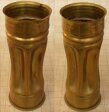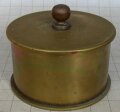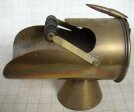Trench Art
I started collecting trench art in the mid 1960s, although I didn't actually hear that term used for it until around the late 1980s. Before that it was just "things made from shell cases" and many sellers were in fact unaware what they were selling until it was pointed out to them.
From the moment I saw my first piece - a small cannon, it's barrel made out of a .22 bullet and two pennies, one Victorian, the other Edwardian, for the wheels of the gun carriage - I was hooked. As I held it in my hand I could see the ingenuity, share the pathos and the poignancy and feel transported back to that time of innocence and carnage - the flower of youth falling in a foreign field.
Very quickly I learned to recognise shell case brass from fifty paces, no matter how buried in the flotsam and jetsam of a crowded junk shop, Sunday market, or, more recently, car boot sale stall. The brass is thicker than most modern commercial brass and has a look and lustre all of its own. And then, of course, for absolute confirmation there is the excitement of turning it over and reading the unique markings on the base which give date and provenance.
I collected whatever I could find and every time I thought I had seen everything that could be made out of a shell case I would come across something I had never seen before - butter knives, sugar barrels shaped as coal scuttles, ashtrays, vases and boxes, ornately and painstakingly hammer decorated by an artist, re-shaped by someone with an engineering bent, or formally etched with regimental colours and battle honours. Each one unique and with it's own story.
Poignant stories - the ashtray and matchbox holder made by a private for an officer in a P. O. W. camp "in gratitude for his kindness", the small coin, one side rubbed down and inscribed that it was "the second prize in the mile run along the trenches in 1916"! (Very sadly I lost this piece when I moved to my current house, but remember it with special feeling as it really symbolised what the growing collection meant to me).
Amazingly to me, trench art was and still is a rather "secret society" sort of collecting. Almost nobody in the 1960s, and relatively few even today, have heard of trench art, there are no real specialist shops, auctions, or publications promoting it - apart from sites such as ebay which have at least served to gather collectors together, thereby giving more visibility to the market. So finding treasures was such fun and the price then and now has always been very affordable.
So what's the downside!! Weight and space! I had a shelf built all the way round my walls and ashtrays etc. on almost every surface, many in everyday practical use, but still a lot of them!! The thought of moving again with that weight is definite motivation to slim down the collection.
One major thing that always stopped me previously was the feeling that there should be a definitive book written on the subject because it so deserved it. I even took a few steps towards doing it myself - contacting photographers, writing introductions, thinking about the research required to do the content. Perhaps just pictures and a very few words, let the pieces stand for themselves - but even the thought of the technical difficulties associated with getting good enough photographs was quite enough to give me pause. However, I felt the collection must be kept together in case it was ever needed for "the book".
And then, in December 2004, I found on the Internet Jane Kimball, herself an avid collector, who was just completing "the book" after several nightmare years of preparation. We corresponded, I read excerpts, it was the book I had been looking for, the book that needed to be written, that tells not just of the pieces themselves, but truly does justice to the times and the people. Jane told me that if she had realised what she was letting herself in for she would never have embarked on it. I breathed a sigh of relief - this could have been me!!
The book should have been published in November 2004, but, to me not by chance, was delayed until early 2005. It is a book for our times, telling a story that needs to be told and being published at such a powerful time in all our lives - in a post 9/11 world, with the dual tragedies of the Iraq war and the 2004 Christmas tsunami to remind us of the fragility, yet magnificence, of man in the face of disaster, natural and man-made.
So - the book has been written. Jane's website tells you far more than I can ever say about the wonders of trench art collecting - and I am freed to turn my physical pieces into happy memories and photographs.
Thomas Hardy wrote a poem on the signing of the Armistice, November 11th 1918, containing the lines
So when old hopes that earth was bettering slowly
Were dead and damned, there sounded "War is done!"
To me trench art, timeless symbols of life created from the weapons of destruction, shows the true resilience of the human spirit and hope's refusal to stay "dead and damned" for long.
I look forward to disseminating my collection around the world and trust that each piece will serve both as a reminder of that resilience and a beacon of hope to it's owner.
Liz Carter, March 2006
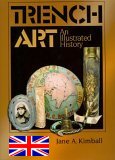 |
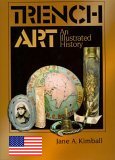 |

